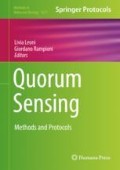Abstract
Fluorescence spectroscopy is an important analytical tool which is widely employed to study biological systems. This technique can be applied to qualitatively and quantitatively probe protein-ligand interactions primarily because of its sensitivity, selectivity, nondestructive and rapid form of analysis. In this chapter we describe the utility of this technique to establish a label-free, universal screening protocol for putative γ-butyrolactone (GBL) receptors by exploiting the intrinsic fluorescence of a highly conserved tryptophan residue that constitutes the hydrophobic pocket for GBL binding, a unique feature possessed by this family of receptors. Here we demonstrate this technique using a combination of steady-state fluorescence quenching methods and fluorescence lifetime decay kinetics using CprB protein from Streptomyces coelicolor A3(2) as a model system. Interaction data between CprB and two chemically synthesized GBLs involved in quorum sensing, Cp1 and Cp2, have been used as example.
The original version of this chapter was revised. An erratum to this chapter can be found at https://doi.org/10.1007/978-1-4939-7309-5_28
Access this chapter
Tax calculation will be finalised at checkout
Purchases are for personal use only
References
Bassler BL, Losick R (2006) Bacterially speaking. Cell 125:237–246
Visick KL, Fuqua C (2005) Decoding microbial chatter: cell-cell communication in bacteria. J Bacteriol 187:5507–5519
Camilli A, Bassler BL (2006) Bacterial small-molecule signaling pathways. Science 311:1113–1136
Fuqua C, Greenberg EP (2002) Listening in on bacteria: acyl-homoserine lactone signalling. Nat Rev Mol Cell Biol 3:685–695
Pesci EC, Milbank JB, Pearson JP, McKnight S, Kende AS, Greenberg EP et al (1999) Quinolone signaling in the cell-to-cell communication system of Pseudomonas aeruginosa. Proc Natl Acad Sci U S A 96:11229–11234
Takano E (2006) Gamma-butyrolactones: Streptomyces signalling molecules regulating antibiotic production and differentiation. Curr Opin Microbiol 9:287–294
Holden MT, Ram Chhabra S, de Nys R, Stead P, Bainton NJ, Hill PJ et al (1999) Quorum-sensing cross talk: isolation and chemical characterization of cyclic dipeptides from Pseudomonas aeruginosa and other gram-negative bacteria. Mol Microbiol 33:1254–1266
Barbieri CM, Kaul M, Pilch DS (2007) Use of 2-aminopurine as a fluorescent tool for characterizing antibiotic recognition of the bacterial rRNA A-site. Tetrahedron 63:3567–6574
Munishkina LA, Fink AL (2007) Fluorescence as a method to reveal structures and membrane-interactions of amyloidogenic proteins. Biochim Biophys Acta 1768:1862–1885
Yengo CM, Chrin L, Rovner AS, Berger CL (1999) Intrinsic tryptophan fluorescence identifies specific conformational changes at the actomyosin interface upon actin binding and ADP release. Biochemistry 38:14515–14523
Ghisaidoobe ABT, Chung SJ (2014) Intrinsic tryptophan fluorescence in the detection and analysis of proteins: a focus on Förster resonance energy transfer techniques. Int J Mol Sci 15:22518–22538
Toseland CP (2013) Fluorescent labeling and modification of proteins. J Chem Biol 6:85–95
Wilhelmsson LM (2010) Fluorescent nucleic acid base analogues. Q Rev Biophys 43:159–183
Kim Y, Ho SO, Gassman NR, Korlann Y, Landorf EV, Collart FR et al (2008) Efficient site-specific labeling of proteins via cysteines. Bioconjug Chem 19:786–791
Biswas A, Narayan S, Kallianpur MV, Krishnamoorthy G, Anand R (2015) Mode of DNA binding with gamma-butyrolactone receptor protein CprB from Streptomyces coelicolor revealed by site-specific fluorescence dynamics. Biochim Biophys Acta 1850:2283–2292
Deprez E, Tauc P, Leh H, Mouscadet JF, Auclair C, Hawkins ME et al (2001) DNA binding induces dissociation of the multimeric form of HIV-1 integrase: a time-resolved fluorescence anisotropy study. Proc Natl Acad Sci U S A 98:10090–10095
Natsume R, Ohnishi Y, Senda T, Horinouchi S (2004) Crystal structure of a gamma-butyrolactone autoregulator receptor protein in Streptomyces coelicolor A3(2). J Mol Biol 336:409–419
Bhukya H, Bhujbalrao R, Bitra A, Anand R (2014) Structural and functional basis of transcriptional regulation by TetR family protein CprB from S. coelicolor A3(2). Nucleic Acids Res 42:10122–10133
Biswas A, Swarnkar RK, Hussain B, Sahoo SK, Pradeepkumar PI, Patwari GN et al (2014) Fluorescence quenching studies of gamma-butyrolactone binding protein (CprB) from Streptomyces coelicolor A3(2). J Phys Chem B 118:10035–10042
Lackowicz JR (2006) Quenching of fluorescence. In: Principles of fluorescence spectroscopy. Springer, Boston, USA
Author information
Authors and Affiliations
Corresponding author
Editor information
Editors and Affiliations
Rights and permissions
Copyright information
© 2018 Springer Science+Business Media LLC
About this protocol
Cite this protocol
Mariam, J., Anand, R. (2018). Fluorescence Quenching Studies of γ-Butyrolactone-Binding Protein (CprB) from Streptomyces coelicolor A3(2). In: Leoni, L., Rampioni, G. (eds) Quorum Sensing. Methods in Molecular Biology, vol 1673. Humana Press, New York, NY. https://doi.org/10.1007/978-1-4939-7309-5_11
Download citation
DOI: https://doi.org/10.1007/978-1-4939-7309-5_11
Published:
Publisher Name: Humana Press, New York, NY
Print ISBN: 978-1-4939-7308-8
Online ISBN: 978-1-4939-7309-5
eBook Packages: Springer Protocols

